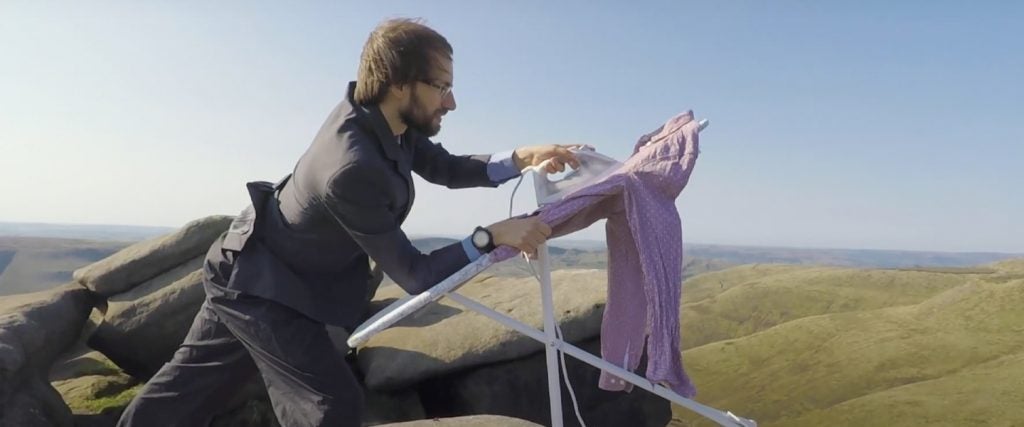Everyone’s got that one thing they do that defies any sensible logic. For Matthew Battley, it’s hiking up Mount Ruapehu — an active volcano on the north island of New Zealand where 80-mile-per-hour winds whip across the summit — to iron a button-down shirt. “I’m afraid that the iron doesn’t do a terribly good job of ironing clothes in the wilderness, but it’s a somewhat pointless venture anyway since you tend to put the item you’ve ironed back into a bag after the ironing anyway, so any gains are short-lived,” explains Battley, a PhD student at the University of Warwick in the U.K. studying young exoplanets.
At 27, Battley, whose professional work experience includes everything from spacecraft design to inductive power transfer systems, first got into extreme ironing with a few friends back in January 2017. “A group of us from the Auckland University Tramping Club were trying to work out the weirdest thing to take up a mountain,” he says. Naturally, they landed on an ironing board. So they packed the ironing board into the largest bag someone had and spent the morning hiking up the snowy volcano. “But it poked a long way out the top [of the bag] regardless,” Battley adds.
This might all seem like a farce. Which it is. But it’s also not. Or at least, it’s a serious enough activity (sport?) to have two competing origin stories. According to some, Englishman Tony Hiam invented it in England’s Yorkshire Dales National Park in 1980. The story goes that Hiam was inspired by his eccentric brother-in-law who ironed his clothes even when camping in a tent.
Others claim extreme ironing was started in 1997 in Leicester, England, by Phil Shaw in his back garden. In his book on extreme ironing, Shaw writes that he came home from a hard day working in a knitwear factory knowing he still had household tasks to take care of, one of which was ironing his shirts. But rather than succumb to the ennui of mundane domestic chores, Shaw took his ironing board outside where he could work out a crisp crease in the fresh air.
Two years later, Shaw decided to introduce the rest of the world to his small act of rebellion. He traveled with his board to the U.S., Fiji, New Zealand, Australia and South Africa. Eventually, a chance encounter with German tourists in New Zealand led to the formation of a group called Extreme Ironing International, and the German Extreme Ironing Section. In 2002, the 1st Extreme Ironing World Championships were held in Bavaria, where 12 teams from nine countries faced off in a steamy competition.
According to the BBC, the teams were judged on their creative ironing skills as well as the quality of the creases in the clothing, which included tea towels, T-shirts and boxer shorts. The winning prize consisted of a Hawaiian vacation, a washing machine and other household goods. “Early on in the contest, James ‘Basket’ Ireson, a 24-year-old engineer also from Leicester, impressed the judges with a spectacular effort on the rocky section, which involved hanging upside down with his ironing board using ropes and a pulley mechanism,” per the BBC. (The paramedics were only called once that day after a member of the German team went through the glass of a car window during a daring press from inside the vehicle.)
But for Battley and his friends, who back in 2017 situated themselves next to Mount Ruapehu’s crater lake and heated up their irons on geothermally warmed rocks, it’s not the competition that matters. “It’s the sheer ridiculousness of taking an ironing board somewhere where it definitely shouldn’t be,” he tells me.
Battley says that physically getting an ironing board into some of the more extreme places he’s gone is usually the biggest challenge. “Often the hardest sections are getting through thick forest — thanks to low-hanging branches — or up more scrambly climbs,” he explains. “I definitely recommend using some rope to tie around the ironing board and pull it up behind you when you need your hands free for climbing. It also helps to suspend the ironing board halfway up walls or cliffs for some more extreme positions.”
As for his ultimate goal, Battley says he’d love to try ironing halfway up a vertical outdoor climb or underwater somewhere. He does, however, stipulate that every new locale has its own unique charms. “In the short term, I’d like to iron on the Adam and Eve stones on the top of Mount Tryfan in Wales, as it’d be an absolutely perfect spot for it with a superb view,” he says.
Sadly, the pandemic has slowed down extreme ironing considerably for Battley and his crew. “But I generally try to find at least one to two new places each year to iron — or more when I’ve got the time,” he tells me. Over the years, he’s taken his board along with him to a Scottish loch, inside an old lava tunnel and multiple national parks in the U.K.
He’s even added a new chapter to the storied history of extreme ironing. “On the way down [the summit], we also tried our hand at ‘extreme iron-boarding,’” he says. By turning the ironing board upside down, Battley was able to ride it back down the glacier. “It doesn’t make the best snowboard,” he admits. “But at least it does have handles to hold on to.”

